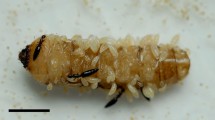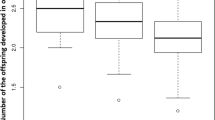Abstract
This study examines the sex ratio response of the parasitoid wasp Muscidifurax raptor to conspecific and confamilial females in relation to two groups of functional sex ratio models, local mate competition and host quality models. In some but not all experiments, M. raptor females produced a greater proportion of sons in the presence of a conspecific female than when alone, and this sex ratio effect carried over for a day after the females were isolated from each other M. raptor females also produced a greater proportion of sons in the presence of a female of the confamilial parasitoid Spalangia cameroni than when alone (although only on the second day of exposure to S. cameroni, not on the first). M. raptor's sex ratio increase in the presence of conspecifics is consistent with local mate competition models but not with host quality models because the presence of a conspecific female did not cause there to be more, and thus potentially smaller, offspring developing per host. In contrast, the presence of a S. cameroni female did cause there to be more offspring developing per host than when a M. raptor female was alone; thus M. raptor's sex ratio increase in the presence of S. cameroni may be explained by host quality models. An alternative explanation for the sex ratio increase in response to confamilials is that only a sex ratio response to conspecifics may be adaptive, due to local mate competition; but M. raptor females may be unable to distinguish between conspecific and S. cameroni females.
Similar content being viewed by others
References
Abidi AZ, Kumar A, Tripathi CPM (1988) Impact of males on the sex ratio of Diaretiella rapae (McIntosh) (Hymenoptera: Aphidiidae), a parasitoid of Lipaphis erysmi Kalt. (Hemiptera: Aphididae). Bull Inst Zool Acad Sin (Taipei) 27: 205–209
Antolin MF (1992) Sex ratio variation in a parasitic wasp I. Reaction norms. Evolution 46: 1496–1510
Butler JF, Escher RL, Hogsette JA (1981) Natural parasite levels in house flies, stable flies, and horn flies in Florida. In: Proceedings of Workshop on Status of Biological Control of Filth Flies. United States Department of Agriculture, pp 61–79
Charnov EL (1979) The genetical evolution of patterns of sexuality: Darwinian fitness. Am Nat 113: 465–480
Charnov EL (1982) The Theory of Sex Allocation. Princeton University Press, Princeton, NJ
Charnov EL, Los-Den Hartogh RL, Jones WT, Assem J van den (1981) Sex ratio evolution in a variable enviroment. Nature 289: 27–33
Dijken MJ van (1989) Sex allocation in Epidinocarsis lopezi: local mate competition. Entomol Exp Appl 52 249–255
Frank SA (1985) Are mating and mate competition by the fig wasp Pegoscapus assuetus (Agaonidae) random within a fig? Biotropica 17: 170–172
Hamilton WD (1967) Extraordinary sex ratios. Science 156: 477–488
Herre EA (1985) Sex ratio adjustment in fig wasps. Science 228: 896–898
Herre EA (1987) Optimality, plasticity and selective regime in fig wasp sex ratios. Nature 329: 627–629
King BH (1987) Offspring sex ratios in parasitoid wasps. Q Rev Biol 62: 367–396
King BH (1988) Sex-ratio manipulation in response to host size by the parasitoid wasp Spalangia cameroni: a laboratory study. Evolution 42: 1190–1198
King BH (1989) A test of local mate competition theory with a solitary species of parasitoid wasp, Spalangia cameroni. Oikos 54: 50–54
King BH (1991) A field study of host size effects on sex ratio of the parasitoid wasp Spalangia cameroni. Am Midl Nat 125: 10–17
King BH (1993) Sex ratio manipulation by parasitoid wasps. In: Wrensch DL, Ebbert M (eds) Evolution and diversity of sex ratio in insects and mites. Chapman and Hall, NY
Kumar A, Tripathi CPM (1987) Parasitoid-host relationship between Trioxys (Binodoxys) indicus Subba Rao and Sharma (Hymenoptera: Aphidiidae) and Aphis craccivora Koch (Hemiptera: Aphidiidae).: Effect of host plants on the sex ratio of the parasitoid. Entomonology 12(2): 95–99
Kuno E (1962) The effect of population density on the reproduction of Trichogramma japonicum Ashmead (Hymenoptera: Trichogrammatidae). Res Popul Ecol 4: 47–59
Legner EF (1969) Adult emergence interval and reproduction in parasitic Hymenoptera influenced by host size and density. Ann Entomol Soc Am 62: 220–226
Markwick NP (1974) A comparative study of four housefly parasites (Hymenoptera: Chalcidoidea). PhD Thesis, Victoria University, Wellington, New Zealand
Meyer JA, Schultz TA, Collar C, Mullens BA (1991) Relative abundance of stable fly and house fly (Diptera: Muscidae) pupal parasites (Hymenoptera, Pteromalidae-Coleoptera, Staphylinidae) on confinement dairies in California. Environ Entomol 20: 915–921
Mullens BA, Meyer JA, Mandeville JD (1986) Seasonal and diel activity of filth fly (Musca domestica) parasites (Hymenoptera: Pteromalidae) in caged-layer poultry manure in southern California. Environ Entomol 15: 56–60
Norusis MJ (1988) SPSS/PC + advanced statistics V2.0. SPSS Inc., Chicago, IL
Nunney L, Luck RF (1988), Factors influencing the optimum sex ratio in a structured population. Theor Popul Biol 33: 1–30
Propp GD, Morgan PB (1985), Effect of host distribution on parasitoidism of house-fly (Diptera: Muscidae) pupae by Spalangia spp. and Muscidifurax raptor (Hymenoptera: Pteromalide). Can Entomol 117: 515–524
Rueda LM, Axtell RC (1985) Guide to common species of pupal parasites (Hymenoptera: Pteromalidae) of the house fly and other muscoid flies associated with poultry and livestock manure. Technical Bulletin 278. North Carolina Agricultural Research Service. North Carolina State University
Scheffé H (1959) The analysis of variance. J. Wiley and Sons, NY
Schwartz A, Gerling D (1974) Adult biology of Telenomus remus (Hymenoptera: Scelionidae) under laboratory conditions. Entomophaga 19: 483–492
Seidl SE (1992) Sex ratio manipulation by the parasitoid wasp Muscidifurax raptor in response to host size and female wasp density. MS Thesis, Northern Illinois University, DeKalb, IL, USA
Strand MR (1988) Variable sex ratio strategy of Telenomus heliothidis (Hymenoptera: Scelionidae): adaptation to host and conspecific density. Oecologia 77: 219–224
Viktorov GA (1968) Influence of density on the sex ratio in Trissolcus grandis Thoms (Hymenoptera, Scelonidae). Zool Zh 4: 1035–1039
Waage JK (1982) Sex ratio and population dynamics of natural enemies-some possible interactions Ann Appl Biol 101: 159–164
Werren JH (1983) Sex ratio evolution under local mate competition in a parasitic wasp. Evolution 37: 116–124
Wylie HG (1971) Observations on intraspecific larval competition in three hymenopterous parasites of fly puparia. Can Entomol 103: 137–142
Wylie HG (1972) Larval competition among three hymenopterous parasite species on multiparasitized housefly (Diptera) pupae. Can Entomol 104: 1181–1190
Wylie HG (1973) Control of egg fertilization by Nasonia vitripennis (Hymenoptera: Pteromalidae) when laying on parasitized house fly pupae. Can Entomol 105: 709–718
Wylie HG (1979) Sex ratio variability of Muscidifurax zaraptor (Hymenoptera, Pteromalidae). Can Entomol 111: 105–107
Author information
Authors and Affiliations
Rights and permissions
About this article
Cite this article
King, B.H., Seidl, S.E. Sex ratio response of the parasitoid wasp Muscidifurax raptor to other females. Oecologia 94, 428–433 (1993). https://doi.org/10.1007/BF00317119
Received:
Accepted:
Issue Date:
DOI: https://doi.org/10.1007/BF00317119




